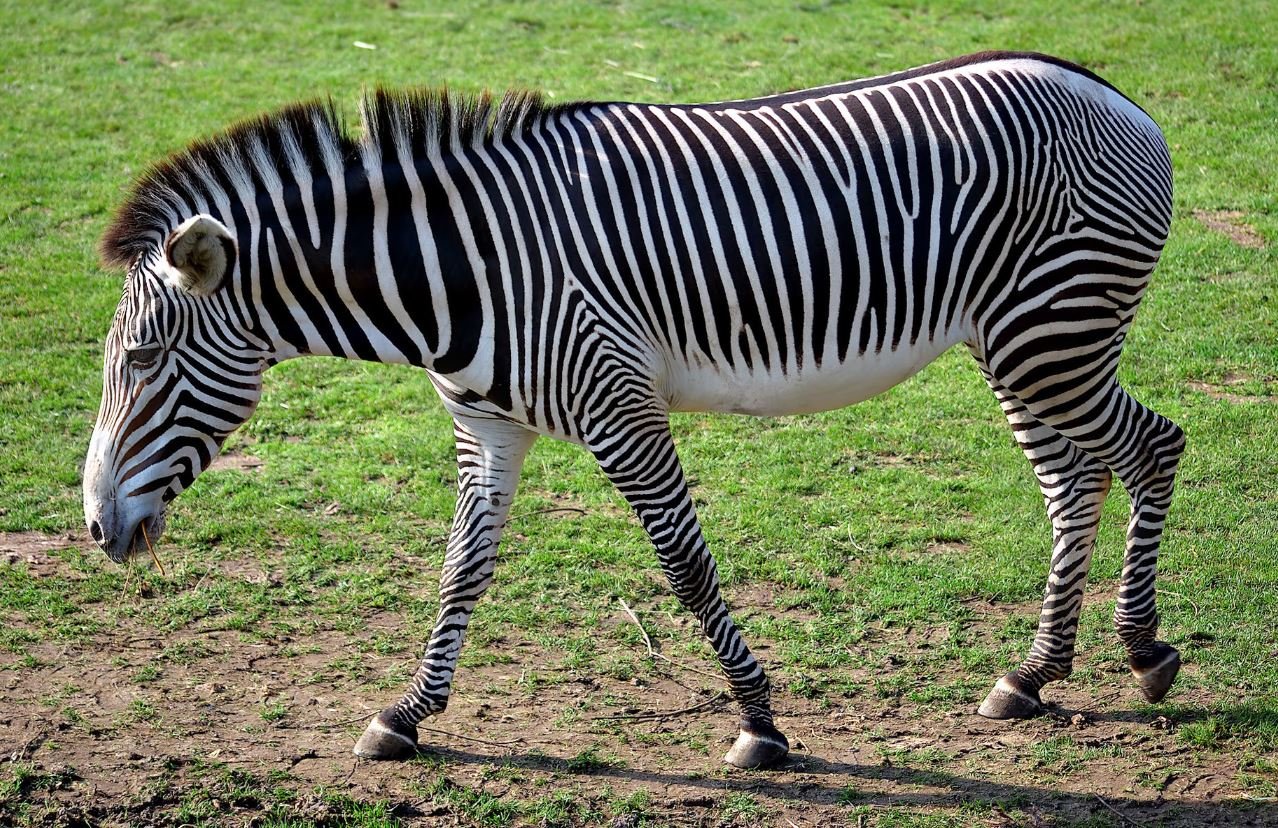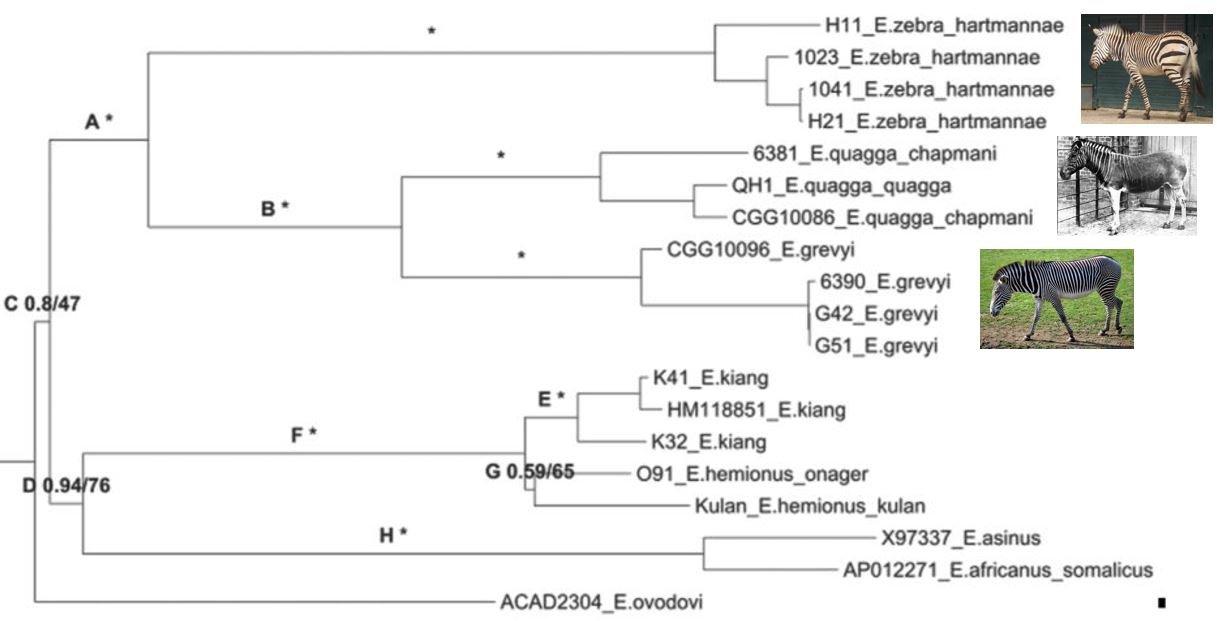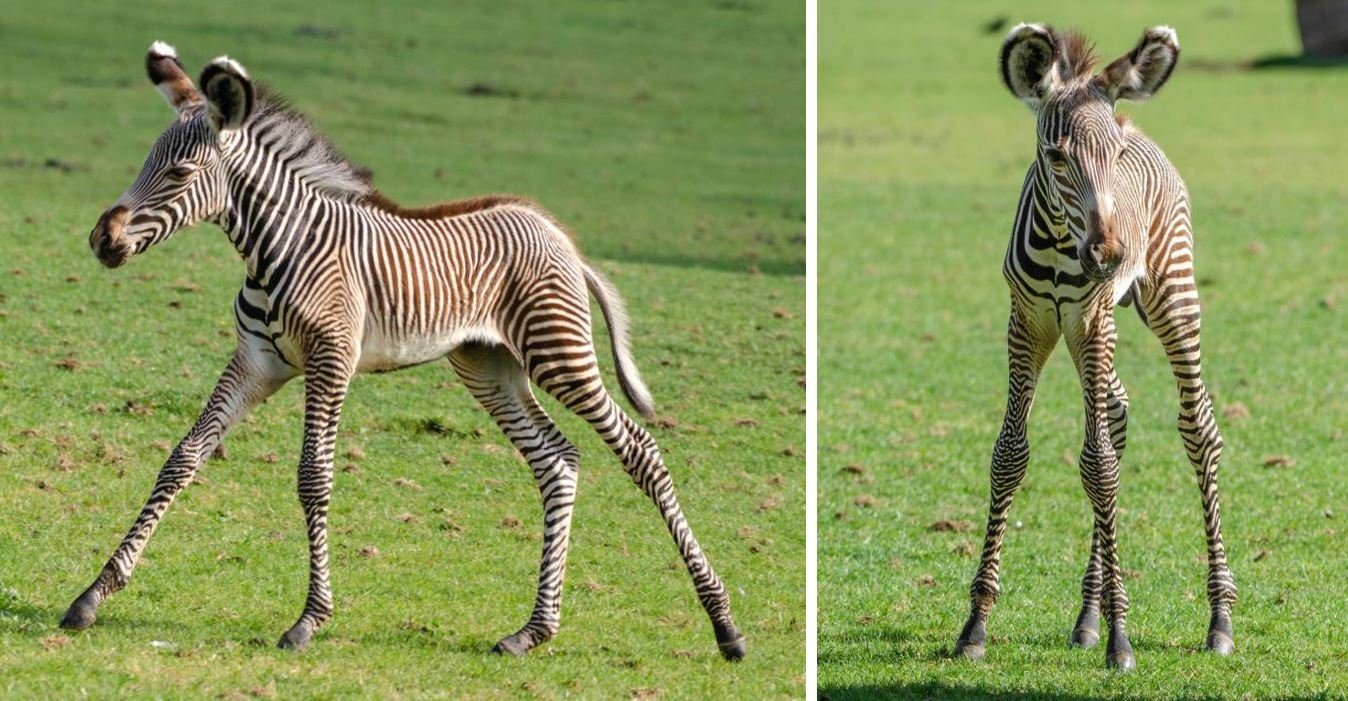Back in October 2022, we looked at the diversity and evolution of plains zebras, a group that includes the Quagga. Here, we carry on with the zebra series, this time looking at Grevy’s zebra….
Caption: captive Grevy’s zebra in side view. Note the long face, the very close spacing of the striping across most of the body and limbs, and the tiny size of the chestnuts on the inside of the forelimb. Image: André Karwath, CC BY-SA 2.5 (original here).
Grevy’s zebra is, I think, the most remarkable and unusual of the zebras. Its scientific recognition is owed to Menelik II, King of Shewa and Emperor of Ethiopia, who gifted a live one to the French president Jules Grévy in 1882. This animal was kept in the Ménageie du Jardin des Plantes but unfortunately died a few days later. This individual was then scientifically described by French zoologist Jean-Fréderic Émile Oustalet, who named it Equus grevyi.
Caption: the type specimen of Grevy’s zebra – when alive – at the Ménageie du Jardin des Plantes, as depicted by Henri Viallanes in 1882. Some sources say that this animal was in poor condition on arrival; this might explain why its mane doesn’t look normal in this illustration. Image: public domain.
It was then realised that this was the same kind of zebra as that depicted in Egyptian artwork and known to the Romans (and even used in their circuses). Remarkably, people outside of Africa had failed to realise that it was different from other zebra kinds, and had thus overlooked its existence for about 1000 years. The full history of the discovery and recognition of Grevy’s zebra is more complex than this and I might come back to it at another time.
Grevy’s zebra is so distinctive relative to other zebras that it was given its own subgenus – Dolichohippus – by Richard Lydekker in 1916. At least some literature from the past few decades still uses this name, since some authors have been kind to the idea that Grevy’s zebra might warrant special taxonomic recognition (read on…). Incidentally, the species name is of course properly written ‘Grévy’, but this isn’t used much in the English language.
Today, Grevy’s zebra is unique to northern Kenya and Ethiopia and is endangered, with a declining population of around 2200 (as of 2020). Hunting explains much of its decline, but loss of habitat to livestock farming is its main threat today. Its historical distribution involved Somalia, Eritrea and Djibouti in the north. Introduced individuals occur in Kenya and it has apparently been undergoing a southward expansion of its range since about 1980 (Cordingley et al. 2009). There is some implication from its favoured habitat that it’s specialised for grasslands on sand-dominated sediments that are either seasonally waterlogged or degraded by repeated burning or elephant use (Kingdon 1997).
Caption: captive Grevy’s zebra at Marwell Zoo, UK. Note the different ear poses, these animals sending different signals. Like all zebras, individuals are of course variable in the details of their striping. Image: Darren Naish.
Grevy’s zebra is big relative to other zebras (400 kg, vs 240 kg for a typical plains zebra) and is the largest wild-living equid of modern times, reaching 1.5m at the withers. It’s long-faced, has large, broad ears, a tall, erect mane, a thinly furred tail, relatively broad hooves, and small, inconspicuous chestnuts (these are the horny excrescences present on the inner surfaces of equid limbs; in zebras, they’re limited to the forelimbs alone). Those big ears and lack of hairiness on the tail might represent adaptation to arid habitats, and they appear convergent with similar features in the also arid-adapted wild asses (Bennett 1980).
The most archaic of zebras…. An anatomical feature which has been deemed significant is that the metapodial splints of Grevy’s zebra – the slim relicts of the ancestral lateral and medial metacarpals and metatarsals – are long and prominent compared to those of other modern equids (Groves 1974). This has been taken as showing that Grevy’s zebra is more structurally archaic than other zebras and indeed other living equids, in which case it can’t be part of the same clade as plains and mountain zebras, this in turn meaning that zebras are non-monophyletic. The teeth have also been regarded as primitive, being relatively small and in possession of thin enamel and a ‘primitive’ degree of enamel folding (Groves 1974, Bennett 1980). Grevy’s zebra has also been considered especially similar to fossil horses from the Pleistocene, like E. stenonis from Europe and north Africa, this resulting in the implication that it’s a conservative ‘living fossil’.
Caption: Grevy’s zebra skeleton, the close-ups at right showing skeleton of the left forelimb in anterior and oblique anterolateral views. The splints – marked by arrows – are said to be longer and more prominent than those of other living equids. Image: H. Zell, CC BY-SA 3.0 (original here).
However, the idea that Grevy’s is an archaic horse outside the clade that includes other zebras is not supported by molecular data. This appears to show that zebras are a clade, and that Grevy’s zebra is nested within that clade where it’s closer to plains zebras than mountain zebras (e.g., George & Ryder 1986, Groves & Ryder 2000, Leonard et al. 2005, Steiner & Ryder 2011, Vilstrup et al. 2013).
Caption: equid phylogeny based on mitochondrial DNA from Vilstrup et al. (2013). Grevy’s zebra and plains zebras (which include the Quagga) form a clade, and mountain zebras are their sister-group. The icons were not included in Vilstrup et al. (2013). Images (top to bottom): Darren Naish; public domain; André Karwath, CC BY-SA 2.5 (original here).
Caption: reclining Grevy’s zebras in captivity, showing certain of the key traits of the species. These include the large ears, the prominent white of the belly, and the thick black dorsal stripe, bordered by white. Image: Darren Naish.
Whatever its evolutionary position, Grevy’s zebra is unique and unmistakeable in pigmentation. The stripes are thin, black and very closely spaced, there’s a thick black dorsal stripe bordered by white, and the whiteness of the belly extends relatively far up the animal’s sides. The striping on the rump involves the junction of three stripes sets: fine, anteriorly convex curves that descend from the root of the tail, more vertical, posteriorly convex curves that approach the tail from the flank, and sub-horizontal stripes that ascend the side of the leg. There’s no obvious or consistent anatomical variation across the species, and thus no push to recognise subspecies (Groves & Bell 2003).
Behaviour and foals. Grevy’s zebra is unusual in behavioural terms too, with a fluid, dynamic social system that’s mostly based around male territoriality. Males control territories (marked by dung piles) and fight other males so long as females are within those territories; fighting only occurs at territory boundaries, and males within a stranger’s territory display submission. Females are nomadic and associate and disassociate with other females on a seemingly ad-hoc basis, though they gather in small groups when in care of young foals (Becker & Ginsberg 1990).
Caption: wild herd of Grevy’s zebra in acacia-dominated scrub. Image: Daniel Fafard, CC BY-SA 3.0 (original here).
Another unique feature is that foals stay put while their mothers disappear to find water. Older reports (like that published by Hans Klingel in 1974) led some authors to think that the foals were alone and abandoned during such times (Groves 1974). It now seems that the foals are left in the care of an adult, “usually a territorial male” (Becker & Ginsberg 1990, p. 1111), and that this behaviour is another specialisation for arid environments. Lactating mothers need drinking water while nursing foals don’t.
They live into their 20s and are slow breeders, gestation taking 13 months: the longest of any equid. Foals can stay with their mothers for up to three years but are precocial in terms of feeding behaviour relative to other equids, eating grass for sustained periods at a much younger age than do the young of other equids. The foals have an unusual hairy crest – I wouldn’t call it a mane – running along the dorsal midline all the way to the tail. A subtler hairy fringe is also present along the bellies of young foals.
Caption: Grevy’s zebra foals possess the very fine, intricate striping of adults, but raised fringes of hair along the dorsal and ventral midline are unusual to them. The limbs of juvenile equids are hilariously long. Images: PhotosByGemma (originals here).
Surprising hybrids. For all its comparative weirdness, Grevy’s is still able to hybridise with plains zebras. Groves (1974) wrote that Grant’s and Grevy’s zebras occurred in mixed herds where they coexist (namely, the arid country around Baragoi and Wamba, and on the grasslands of the Leroghi or Loroghi Plateau, Kenya), but that “no hybrids are known” (p. 156). However, wild hybrids between the two are known today, specifically from the Laikipia region of northern Kenya, which is just to the south of the area that Groves was writing about. The animals concerned look like hybrids, with sizes, stripe configurations and ear shapes intermediate between plains and Grevy’s zebras, and have been confirmed as such by genetic analysis (Cordingley et al. 2009).
Caption: Grevy’s zebra x plains zebra hybrids, as depicted by Cordingley et al. (2009). The animals at right are a hybrid mother and her second-generation hybrid foal. Images: Cordingley et al. (2009).
The hybrids take up a plains zebra lifestyle rather than a Grevy’s zebra one, and in fact appear fully integrated within plains zebra society. The female hybrids join plains zebra harems (controlled by plains zebra stallions), and the male hybrids have been observed defending plains zebra harems or hanging out in bachelor groups with plains zebras (Cordingley et al. 2009, Schieltz & Rubenstein 2015). 22 hybrid individuals were identified in a 2007 survey, so there are no indications that a substantial hybrid swarm – or anything like it – is on the rise.
Given that Grevy’s zebra is endangered and declining, does this hybridisation represent a threat to its persistence? Cordingley et al. (2009) proposed that it’s happened as a consequence of reduced mating opportunities for the male Grevy’s zebras in the area concerned, but the fact that the hybrids are integrating themselves into plains zebra society – and not diluting the local Grevy’s zebra population – means that “hybridization poses no immediate threat to Grevy’s zebra” (p. 511), and that it’s less of a concern than habitat degradation and loss due to human action.
When identified, Grevy’s x plains zebra hybrids were regarded as unique and unprecedented within wild-living zebras. Since then, mountain zebra x plains zebra hybrids have also been identified.
It’s mountain zebras we’ll be looking at next.
Caption: wild Grevy’s zebra stallion in Kenya. Image: Kevin Walsh, CC BY 2.0 (original here).
For previous Tet Zoo articles on horses, wild and domestic, see…
A day at London’s Grant Museum of Zoology, August 2011 (includes discussion of Quagga and other zebras)
Fantastic asses, September 2013
Spots, Stripes and Spreading Hooves in the Horses of the Ice Age, February 2015
Domestic Horses of Africa, July 2022
The Slightly Surprising Diversity of Zebras, Part 1, October 2022
Refs - -
Bennett, D. K. 1980. Stripes do not a zebra make, part I: a cladistic analysis of Equus. Systematic Zoology 29, 272-287.
Cordingley, J. E., Sundaresan, S. R., Fischhoff, I. R., Shapiro, B., Ruskey, J. & Rubenstein, D. I. 2009. Is the endangered Grevy’s zebra threatened by hybridization? Animal Conservation 12, 505-513.
George, M. & Ryder, O. A. 1986. Mitochondrial DNA evolution in the genus Equus. Molecular Biology and Evolution 3, 353-546.
Groves, C. P. 1974. Horses, Asses and Zebras in the Wild. David & Charles, Newton Abbot and London.
Groves, C. P. & Bell, H. B. 2004. New investigations on the taxonomy of the zebras genus Equus, subgenus Hippotigris. Mammalian Biology 69, 182-196.
Groves, C. P. & Ryder, O. A. 2000. Systematics and phylogeny of the horse. In Bowling, A. T. & Ruvinsky, A. (eds) The Genetics of the Horse. CAB International, Wallingford, UK, pp. 1-24.
Leonard, J. A., Rohland, N., Glaberman, S., Fleischer, R. C., Caccone, A. & Hofreiter, M. 2005. A rapid loss of stripes: the evolutionary history of the extinct quagga. Biology Letters 1, 291-295.
Kingdon, J. 1997. The Kingdon Field Guide to African Mammals. Academic Press, San Diego.
Schieltz, J. M. & Rubenstein, D. I. 2015. Caught between two worlds: genes and environment influence behaviour of plains x Grevy’s zebra hybrids in central Kenya. Animal Behaviour 106, 17-26.
Steiner, C. C. & Ryder, O. A. 2011. Molecular phylogeny and evolution of the Perissodactyla. Zoological Journal of the Linnean Society 163, 1289-1303.















